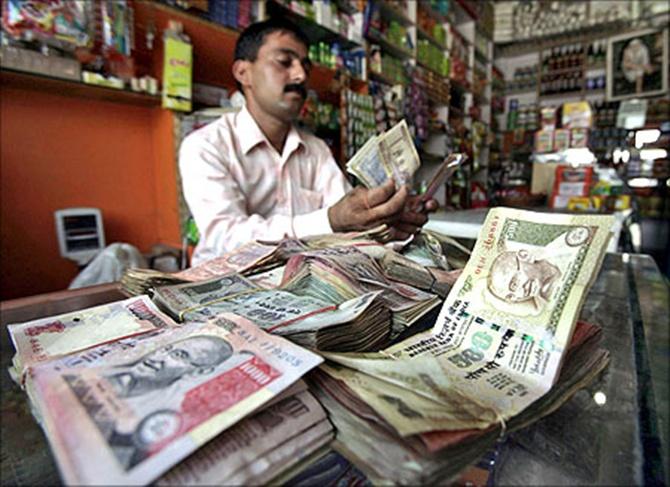 | « Back to article | Print this article |
Why India's 'dream team' has failed
The 1990s team worked wonders because the leaders took care to build a tier of competent secretaries and advisors under them.
India’s economic crisis in 1991 may not be entirely similar to the problems the Indian economy is facing now. But it would be tempting to compare the top policymakers in charge of the economy then with those at the helm now.
First, let us look at the common players in key policy-making positions then and now: Manmohan Singh, who was then the finance minister, is now the prime minister; P Chidambaram - commerce minister then and now the finance minister; C Rangarajan -deputy governor of the Reserve Bank of India (RBI) and a little later RBI governor then and now the chairman of the prime minister’s economic advisory council and; Montek Singh Ahluwalia, who was then secretary in the commerce ministry and later in the finance ministry and is now the deputy chairman of the Planning Commission.
Even Duvvuri Subbarao, at present the RBI governor, was a joint secretary in the finance ministry then, though he was not seen as part of the top policy-making team dealing with the 1991 crisis.
Click NEXT to read more...
Why India's 'dream team' has failed
To have in the current economic policy making team so many of those who had successfully tackled the 1991 economic crisis should have been a major strength.
Many members of the “dream team” of the 1990s are right here to tackle another crisis of 2013, which clearly is not as bad as the one they had handled more than two decades ago.
So, why this sense of panic and why would the government show signs of desperation? Or why would Prime Minister Manmohan Singh bemoan the need for restoring confidence?
One possible reason is perhaps that it is not enough to have leaders of a dream team in place to tackle a difficult economic situation.
Click NEXT to read more...
Why India's 'dream team' has failed
You also need the doers in the team - a bunch of secretaries who are competent and committed to help conceive and implement the necessary policies. In other words, a dream team’s effectiveness is largely determined by the ability of the secretaries and advisors working with it.
This, of course, should not be construed as a clean chit for leaders of the “dream team” of the 1990s, who are still around.
The success of a dream team also lies in its leaders’ ability to create a second tier of strong and competent secretaries and advisors. If the 1990s dream team worked wonders, it is because the top leaders that time took care to build a tier of competent secretaries and advisors under them to carry out economic reforms.
As prime minister then, P V Narasimha Rao, had Amar Nath Varma as his principal secretary in his office. Varma minced no words in ensuring that the tough decisions to be taken to tackle the crisis were implemented without any political trouble, after ensuring the concurrence of all economic ministries.
Why India's 'dream team' has failed
Similarly, Manmohan Singh, as finance minister, put together a strong team of secretaries and advisors that guided economic policy reforms during that period. Ahluwalia was certainly one of them, but there were many other fine officers who made a big, positive difference to policy making those days.
If the “dream team” of the 1990s succeeded, it was largely because the leaders had put together a strong tier of competent doers who would get things done with understanding and commitment.
If you look at the current team, the problem becomes immediately noticeable. Many of the competent secretaries who were part of the 1990s “dream team” are now at the helm today.
Yet, they have failed to build a new tier of powerful and effective secretaries or advisors in the same way the leaders of the 1990s dream team did to great effect.
The leaders of the 1990s “dream team” had the vision of building a strong tier of secretaries to implement their ideas. But today’s leaders have little to show by way of building a second tier of doers.
Click NEXT to read more...
Why India's 'dream team' has failed
Take a look at the Prime Minister’s Office and you will see a lot of continuity, but you would also notice that little attention has been paid to nurturing talents to grow up as the next batch of leaders.
In the finance ministry, the situation appears to be worse. R S Gujral was appointed the finance secretary more than a year ago.
It would be difficult to remember the last time R.S. Gujral, in charge of the expenditure department, was seen to be doing something worth writing about. Gujral was seen to be a wrong choice for the job.
But to have persisted with him for more than a year in that critical job even as the economy is in a crisis shows how the leaders of the “dream team” have ignored the need to put in place a strong and powerful team of bureaucrats to execute the government’s ideas.
Click NEXT to read more...
Why India's 'dream team' has failed
Yes, you have Economic Affairs Secretary Arvind Mayaram, who is the most visible face of the finance ministry, and Revenue Secretary Sumit Bose and Financial Services Secretary Rajiv Takru. But could you compare this team with the one that was at the helm in the finance ministry in the 1990s?
To be sure, the finance ministry has seen the induction of two eminent economists in this period - Raghuram G Rajan as the chief economic advisor and Parthasarathi Shome as advisor to the finance minister.
But, surely, the finance ministry could have identified and nurtured a strong team of civil servants who could have added muscle to the finance ministry’s policy making efforts. Or has India’s steel frame grown so weak that there aren’t too many such civil servants around?






